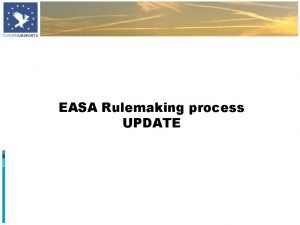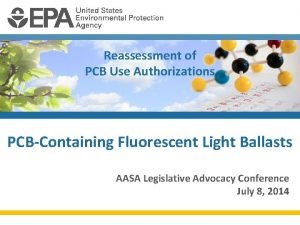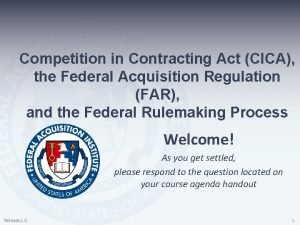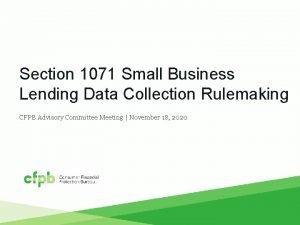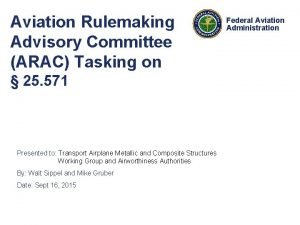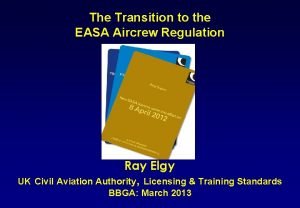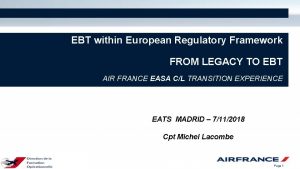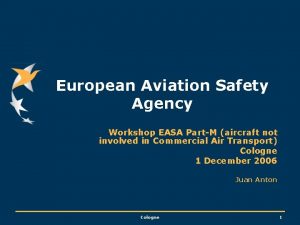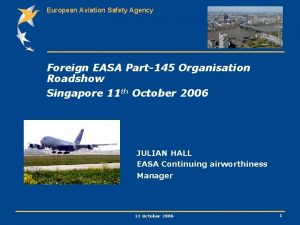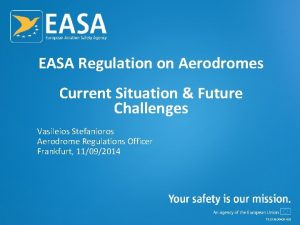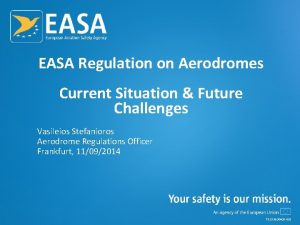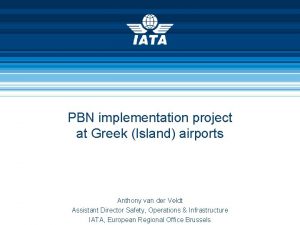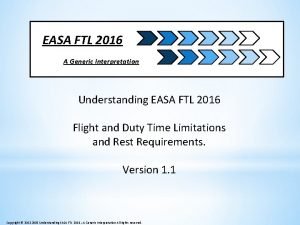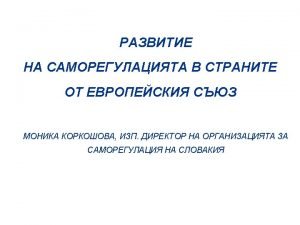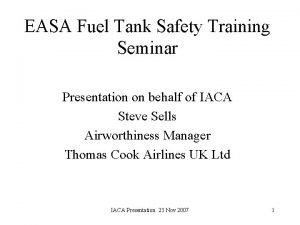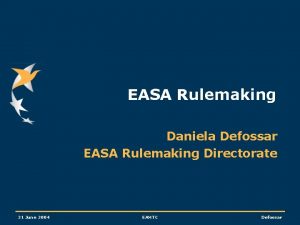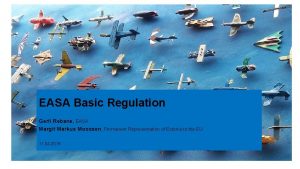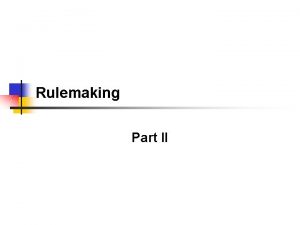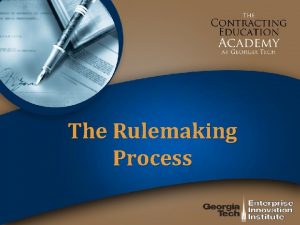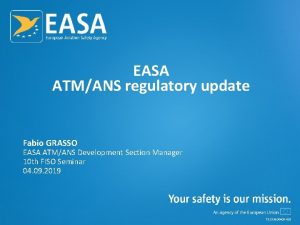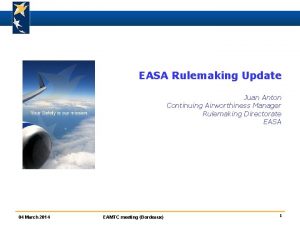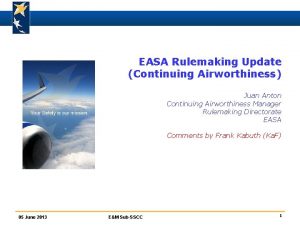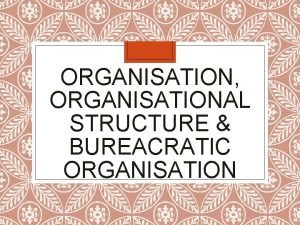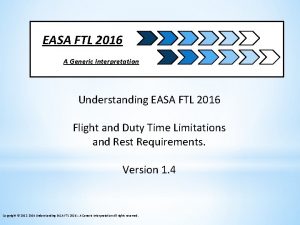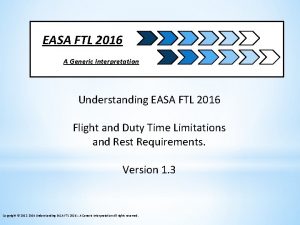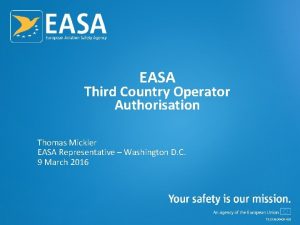EASA Rulemaking process UPDATE Organisation of EU The


















- Slides: 18

EASA Rulemaking process UPDATE

Organisation of EU • The European Parliament • The Council of the EU • The European Commission • Court of Justice • Court of Auditors • European Economic and Social Committee • The Committee of the Regions • The European Central Bank • The European Investment Bank

European Aviation Safety Agency § In July 2002 the EU Council and Parliament have decided to apply common rules to aviation and to establish EASA § Objectives: ensure a high and uniform level of protection of the European citizen and facilitate free movement of goods persons and services § EASA is operational since September 2003 § EASA is located in Cologne § Staff: 450 people § Website: www. easa. eu. int

The Basic Regulation 216/2008 § The Basic regulation of EASA is Regulation (EC) 216/2008 § Basic regulations are not converted into national laws and apply directly § Principles (scope, objectives, definitions) § Substantive requirements (basic principles, applicability, airworthiness, environmental protection, operations and licensing, recognition of certificates, etc…) § Organisation of EASA (tasks, internal structure, working methods, financial requirements, final

Present regulations structure ER : Annexes I to V Basic Regulation (EC) 216/2008 of 20/02/2008 Regulation (EC) 1702/2003 on Airworthiness and Environmental Certification Regulation (EC) 2042/2003 on Continuing Airworthiness Section A: Application Requirements Annex (Part 21) Section B: administrative Procedures Annex I (Part-M): Continuing Airworthiness Requirements Section A: Technical Requirements Annex II (Part-145): Maintenance Organisation Approvals Appendices: EASA forms Agency Opinion Section B: Administrative Procedures Appendices: EASA forms Annex III (Part-66): Certifying Staff Annex IV (Part-147): Training Organisation Requirements Guidance Material Part 21 Parliament and Council European Commission EASA Certification Specifications AMC 20 AMC 21 CS 25 CS 34 CS 36 CS E CS P CS APU CS AWO CS ETSO CS Definitions AMC & Guidance Material CS CS CS 22 23 27 29 VLA VLR Part M, 145, 66, 147 Agency CS , AMC & GM

EASA Rulemaking § 3 types of regulation: § Basic Regulation (216/2008) with Essential Requirements (ER), adopted by the Parliament (Hard Law) § Implementing Rules (IR), adopted by the Commission § Certification Specifications (CS), Acceptable means of compliance (AMC) and Guidance Material (GM) adopted by EASA (Soft Law)

EASA Rulemaking Procedure § For any change in Reg 216/2008 (Essential Requirements), EASA must issue a Notice of Proposed Amendment (NPA) and/or a Regulatory Impact Assessment (RIA) § Stakeholders (we!) must be consulted § Evaluation of the answers by an independent WG § EASA issues a Comment Response Document (CRD) § Stakeholders may comment again § EASA issues an Opinion (draft of the new regulation) which is submitted to the European Commission § The Commission issues a communication to the Council of Ministers and to the European Parliament, stating if they accept or reject the proposal § If accepted the amendment is submitted to the Council and to the Parliament (Co-decision process) § Publication of the new regulation in the Official Journal of EU § Process looks like democratic but it is very time consuming!

EU Rulemaking process flowchart

EASA Chronological order of EASA tasks § Certification (initial airworthiness) § Maintenance (continuing airworthiness) § Licensing (pilot proficiency) and medical § Operations § Short term: Airport Operations § Long term: Air Traffic Services

Current activities in progress CRD to NPA 2008 -07 Initial Airworthiness to be published end of March? ? NPA 2008 -22 Organisation and Authority requirements NPA 2009 -01 OSC- Operational Suitability Ceritificate and Safety Directives NPA 2009 -02 OPS NPA 2009 -03 Update to European Technical Standard Order ETSO-C 119 b


EGAST European General Aviation Safety Team UPDATE

About EGAST European General Aviation Safety Team EGAST is a component of European Strategic Safety Initiative (ESSI) and was founded on 17 October 2007 General Aviation (GA) is a high priority for the European Aviation Safety Agency (EASA). EGAST is a new venture in Europe and a challenge. GA is a dispersed community made of very diverse components such as business aviation, aerial work, air sports and recreational activities. http: //www. easa. europa. eu/essi/egast. EN. html

EGAST Objective As stated by the EGAST Core Team on 1 st April 2008, "EGAST will promote and initiate for all sectors of GA best practices and awareness in order to improve safety, thereby reducing the accident rates. The team may make non binding recommendations. This objective applies to all GA sectors. In addition, specific objectives and priorities may be defined at sector level, depending on safety importance and available resources".

Composition of the team EGAST is composed of representatives of manufacturers, regulators, aero-clubs, accident investigators, international and research organisations. Building on the national General Aviation initiatives in Europe, EGAST creates a forum for sharing best practices, improving data sources, and promoting safety.

EGAST Organisation EGAST is organised in three layers representing different levels of involvement: EGAST Level 1, is the Core Team that runs the initiative. It is composed of around twenty participants reflecting the different GA sectors. EGAST Level 2 is composed of around sixty organisations involved in the initiative, without running it. EGAST Level 3 is the global European GA community, which needs to be informed about EGAST.

EGAST meetings 15. January Cologne The following working-priorities were defined: Risk awareness, decision making enhancement for pilots (and maintenance) Proactive Safety: identification of emerging and future risks for GA 15. April Cologne

If You have any questions, please contact me at: Tel: +420 777 813 040 E-mail: j. fridrich@europe-air-sports. org
 Easa rulemaking process
Easa rulemaking process Rulemaking process steps
Rulemaking process steps Rulemaking process steps
Rulemaking process steps Is an alternative of log based recovery.
Is an alternative of log based recovery. 1071 rulemaking
1071 rulemaking Aviation rulemaking advisory committee
Aviation rulemaking advisory committee Easa ray
Easa ray Easa cm-swceh-001
Easa cm-swceh-001 Airline training atqp, iata ebt
Airline training atqp, iata ebt Easa partm
Easa partm Easa ftl
Easa ftl Easa
Easa Part-camo
Part-camo Easa
Easa Easa ftl regulations combined document
Easa ftl regulations combined document Easa amc 20-27
Easa amc 20-27 Etrtz
Etrtz Advertising and marketing communications
Advertising and marketing communications Fuel tank safety training
Fuel tank safety training
